 |
 |
 |
EAR-TRAINING
My experience is that if your dog's ears are genetically "prick", you will never get a
lasting "tipped" or "tulip" or "breaking" ear without surgery, and of course, a surgically altered
dog is not allowed in the show ring. However, even a genetically prick ear can be trained with alot of diligence and annoyance
on the part of the owner and puppy-dog. Depending on genetics and perseverence, the trained ear, once let out of the brace,
will only look great for a number of hours (enough for a picture or trip around the ring). The ear brace has to be re-applied
constantly during the show season
One breeder years ago, told me to massage each young pup ear with lanolin. I
tried this, and can say that it does not work, and once the lanolin (or other oily lotion) is applied, it must be removed
with alcohol to allow any other brace technique using glue or tape.
Currently, I use a 3/4 inch wide strip of
mole skin (although the sticky side never seems sticky enough) and use "Val-A" or latex glue to bridge the ears
and also glue the ear tips down. I no longer bother with "engine starter fluid" (which is also dangerous) and no
longer bother with the "H" shaped cut for the brace or any brace which involves glue and ties- these are all extra
and unnecessary work. Braces need to be applied every few hours, to every few days, to every week, depending on whether these
are "out-door" dogs and whether there are multiple pups kept together (Playmates will pull off the braces).
Additionally, I've tried proto-type net "ear-bonnets", use of old fashioned foam-plastic human hair curlers,
and different types of clips and weak clamps. None of these stay on long enough to make it effective. (Note, when trying your
own braces, remove those that are obviously painful to your dog!).
Interestingly, I have not heard of a breeder
who is determining his/her selection program based on ear tipping. We all admit that the tulip ear profile is a must for proper
expression, and we are willing to torture ourselves and our dogs to artificially get this look, yet it is not a breeding goal.
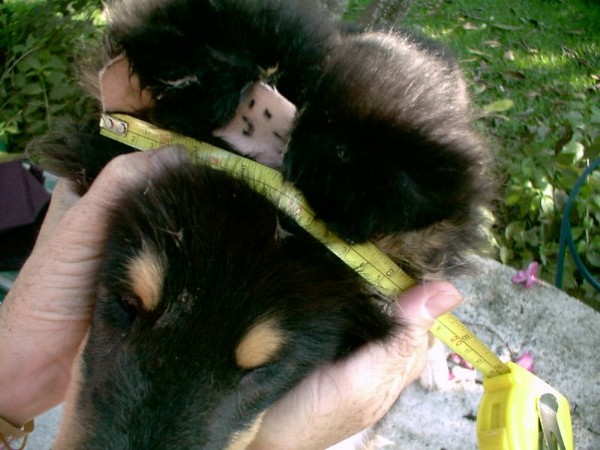
1) EACH BRACE WILL BE MADE TO FIT THE PUP, SO YOU MUST LEARN TO MEASURE THE SIZE THAT YOU WILL NEED BY USING A FLEXIBLE RULER.
USE YOUR HANDS TO MOVE THE EARS TOGETHER AT THE TOP OF THE HEAD AND MEASURE AT THE OUTSIDE OF THE LEFT EAR BASE (WHERE THE
EAR MEETS THE SKULL) TO THE OUTSIDE OF THE RIGHT EAR BASE. OLDER AND MALE PUPS WILL BE LARGER THAN YOUNGER AND FEMALE PUPS.
BEAR, PICTURED HERE, MEASURES 5 AND A HALF INCHES. I WILL USE THIS MEASUREMENT TO TRANSFER ONTO THE MOLESKIN USING A
MARKING PEN (OR ALTERNATIVELY, YOU CAN USE THE CARPET TAPE INSTEAD OF MOLESKIN FOR THE SAME PURPOSE).
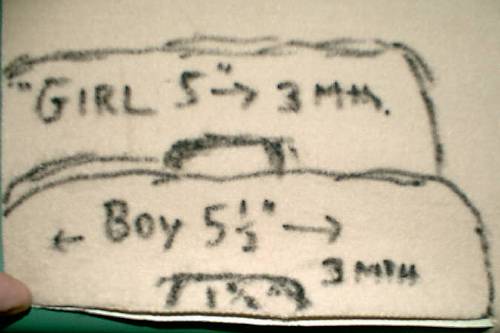
2) PICTURED HERE ARE EAR BRACES DRAWN ON MOLE SKIN TO FIT 15 WEEK OLD BEAR (MALE) AND HIS LITTERMATE, BOW (FEMALE).
THE
LENGTH IS STATED ABOVE AND THE WIDTH IS ABOUT AN INCH AT THE EAR-PIECES (THE ENDS).
ALTERNATIVELY, YOU CAN MAKE THE SAME
DRAWING ON 1" WIDE CARPET TAPE AND USE IT INSTEAD OF MOLE SKIN (IT'S STICKIER AND YOU DO NOT NEED GLUE).
AS YOU SEE,
EACH BRACE IS IN THE GENERAL SHAPE OF AN OLD-MODEL TELEPHONE RECEIVER. THE "EAR PIECES" ARE MADE TO FIT INSIDE
THE BASE OF THE DOG'S EAR.
IF THE BRACE IS MADE TOO SHORT, IT WILL CREATE TOO MUCH TENSION AND PULL OUT. IF THE BRACE
IS MADE TOO LONG, YOU WILL NOT GET THE PROPER POSITIONING OF THE EARS ON TOP OF THE HEAD.
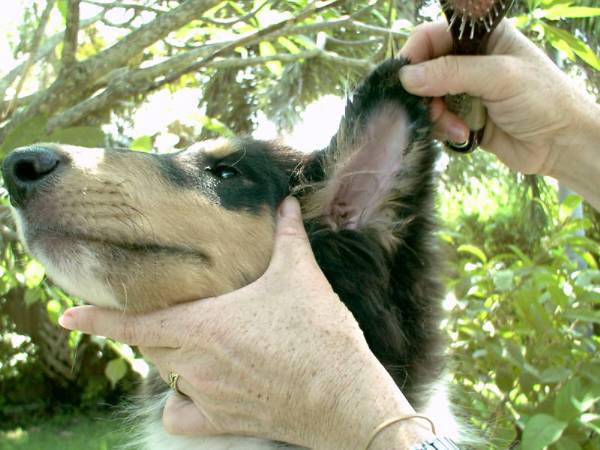
3) BEFORE APPLYING THE EAR BRACE, YOU MUST INSPECT THE EAR FOR ANY SIGNS OF CUTS OR INFECTIONS (AND TREAT ACCORDINGLY).
THEN
REMOVE ANY PREVIOUS GLUE AND DIRT AND WIPE CLEAN THE INSIDE OF THE EAR SKIN (NOT INTO THE EAR CANAL) WITH RUBBING ALCOHOL.
GLUE WILL NOT STICK TO A WAXY/ OILY EAR.
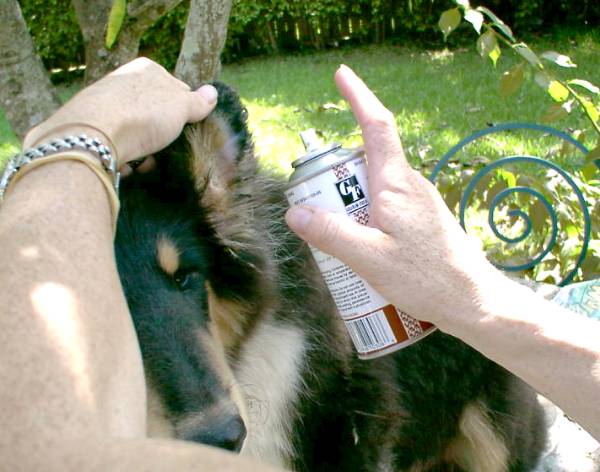
4) NEXT, USE THE TINCTURE OF BENZOIN TO SPRAY (OR PAINT) THE INSIDE OF THE EAR (NOT INTO THE CANAL).
BENZOIN (AEROZOIN)
"PREPARES" AND "CONDITIONS" THE SKIN FOR THE ADHESIVE YOU WILL USE.
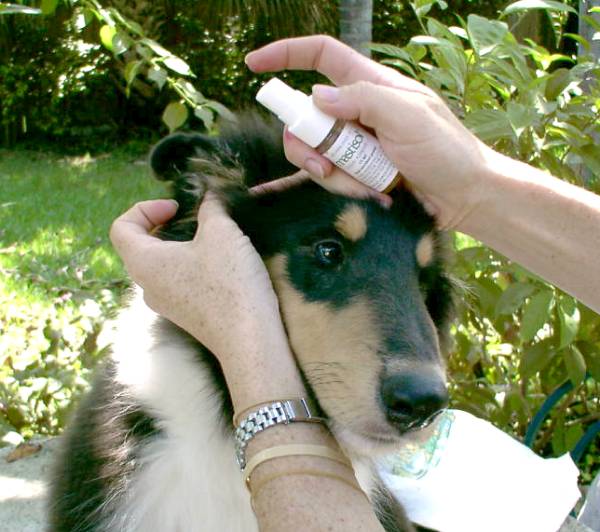
5) HERE I USE MASTISOL (SPRAY OR LIQUID) IN THE INSIDE OF THE EAR. IT IS AN ADHESIVE USED FOR HUMAN SURGICAL NEEDS (OSTOMY
BAG ATTACHMENTS). APPLY THE BRACE BEFORE THE MASTISOL DRIES.
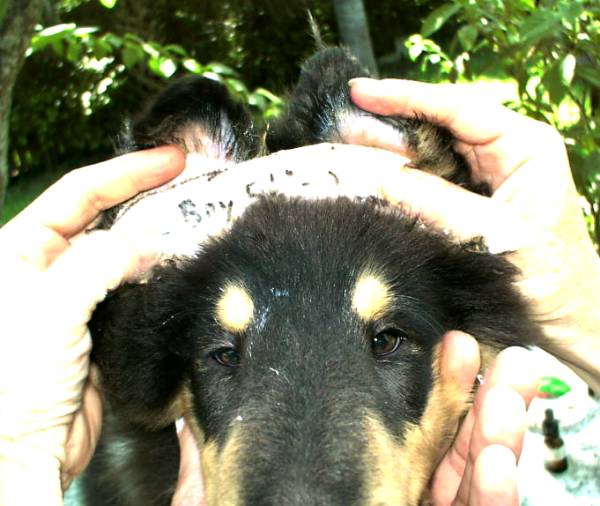
6) IT IS NOW TIME TO APPLY THE BRACE TO THE INSIDE BASE OF EACH EAR. THIS IS THE TRICKIEST PART OF BRACING, SO HAVE SOMEONE
HOLD THE PUP STILL. THE FIRST APPLICATION OF THE BRACE WILL ALWAYS BE THE STRONGEST, AND LAST ONGEST, SO YOU DON'T WANT TO
HAVE TO "ADJUST IT" ONCE YOU APPLY IT TO THE SKIN!
REMOVE THE PROTECTIVE PAPER BACKING FROM THE MOLE SKIN (OR
CARPET TAPE) OF THE AREA WHICH WILL BE THE EAR PIECE, BUT LEAVE THE BACKING ON THE AREA WHICH WILL GO ATOP THE HEAD (THE BRIDGE).
USE ONE HAND TO MOVE THE EARS IN POSITION ON TOP OF THE HEAD, AND HOLD THE BRACE IN THE OTHER HAND. THEN PLACE THE STICKY
SIDE OF THE BRACE INTO THE INSIDE OF THE BASE OF THE EAR. THEN PRESS THE BRACE TO THE SKIN TO MAKE SURE IT STICKS. THEN
PULL THE OTHER EAR CLOSER AND PLACE THE STICKY SIDE OF THE BRACE INTO THE OTHER EAR. PRESS AND SMOOTH.
LET GO AND ADMIRE
YOUR WORK (SEE NEXT PICTURE), BUT DON'T LET YOUR PUP GO YET. THE ADHESIVE NEEDS TO SET BEFORE THE BRACE CAN RESIST THE PUP'S
ATTEMPTS TO SHAKE IT OFF!
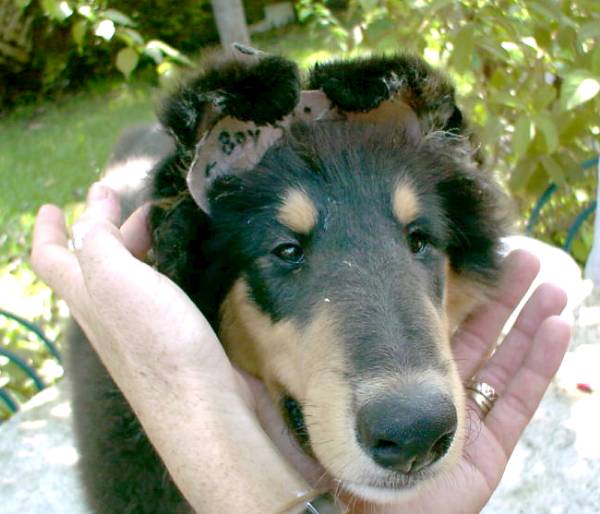
7) TIME TO PAUSE AND ADMIRE THE WORK IN PROGRESS.
BEAR'S EXPRESSION IS ENHANCED WITH HIS EARS PULLED ATOP HIS HEAD.
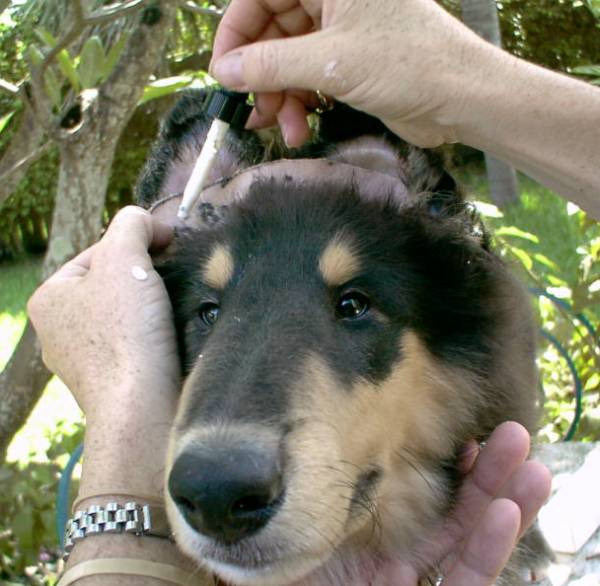
8) CREATING THE "BREAK" IN THE EAR:
PRIOR TO BRACING, REVIEW THE COLLIE CONFIRMATION STANDARD AND PHOTO'S
OF COLLIE SHOW-WINNERS TO UNDERSTAND WHERE THE EAR TIP, OR "BREAK" SHOULD BE.
THE EAR SHOULD BREAK ABOUT ONE
THIRD OF THE WAY DOWN FROM THE TOP AND SHOULD BE PARALLEL WITH THE GROUND.
THE TOP OF THE BRACE SHOULD BE AT ABOUT THE
MIDWAY POINT OF THE INSIDE OF THE EAR (HALF WAY UP/DOWN).
NOW ADD A FEW DROPS OF LATEX (VAL-A) GLUE TO THE NON-STICKY
SIDE OF THE BRACE AND APPROXIMATE THE EAR TIP DOWN TO THE BRACE. THE BREAK SHOULD BE AT ABOUT ONE THIRD OF THE WAY FROM THE
TOP OF THE EAR (TWO THIRDS OF THE WAY FROM THE BOTTOM OF THE EAR).
OF COURSE, YOU WILL NEED TO REPEAT THE GLUING DOWN
OF THE OTHER EAR.
OF COURSE, IF YOU ARE USING THE DOUBLE-SIDED CARPET TAPE INSTEAD OF THE MOLE-SKIN, YOU WILL NOT BE USING
LATEX GLUE. INSTEAD, YOU WILL REMOVE THE PROTECTIVE PAPER BACKING OF THE FRONT SIDE OF THE EAR PIECES, THEN BRNG THE EAR
TIP DOWN TO THE INSIDE OF THE EAR IN THE SAME MANNER.
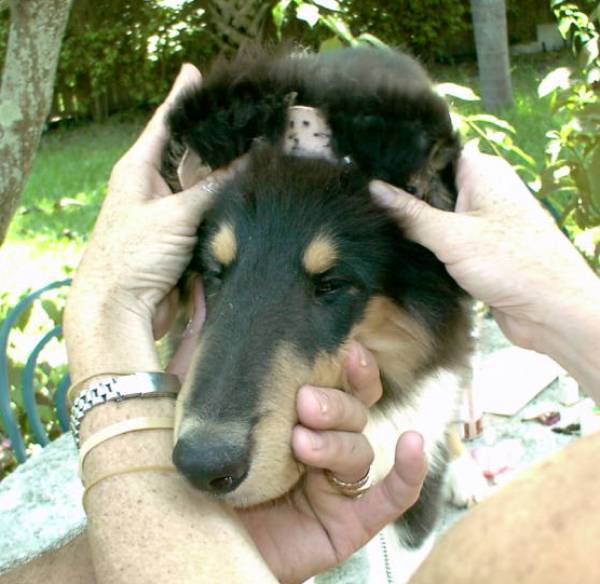
9) WE ARE ALMOST DONE. BEFORE YOU LET GO OF THE PUP, HOLD THE FRESHLY GLUED EAR DOWN FOR THIRTY SECONDS OR SO, TO ALLOW
THE ADHESIVE TO SET.
IF ANY PART OF THE EAR BECOMES LOOSE, YOU WILL HAVE TO USE THE GLUE TO FIX IT. EXCESS LATEX GLUE
IS DIFFICULT TO REMOVE.
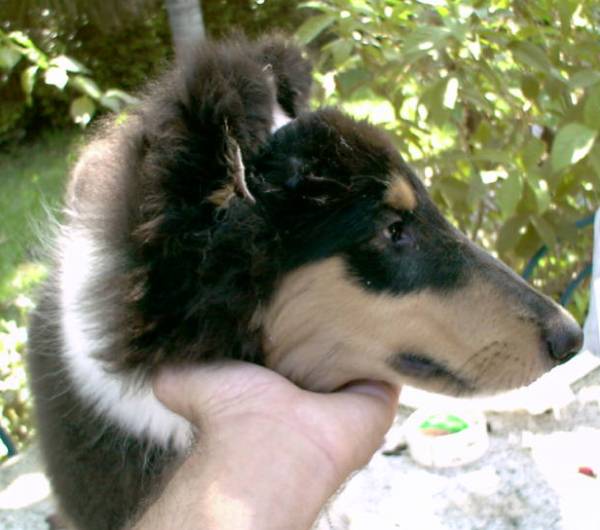
10) WE ARE DONE! THE PUP SURE LOOKS NICE WITH HIS EARS PLACED ON TOP OF HIS HEAD AND THE EAR TIPS BENT AND HELD FORWARD!
HE WILL LOOK EVEN BETTER WHEN THE BRACES ARE REMOVED FOR THE SHOW RING.
PLEASE LOOK INTO YOUR PUPS EARS FREQUENLY
TO MAKE SURE THAT THERE ARE NO INFECTIONS OR ALLERGIC REACTIONS TO THE ADHESIVES.
PUPS SEEM TO TOLERATE THE EAR BRACES
FAIRLY WELL. AFTER A FEW MINUTES OF VIGOROUS HEAD SHAKING OR EAR PAWING JUST AFTER BRACE APPLICATION, THEY WILL RESUME NORMAL
PLAY. IF A PUP CONTINUOUSLY PAWS AT HIS EARS OF SHAKES HIS HEAD, HE MAY HAVE AN INFECTION OR PAINFUL ALLERGIC REACTION- SO
USE THIS AS A SIGN TO INVESTIGATE.
AS I STATED ABOVE, PUPS WILL PLAY HARD WITH THEIR LITTERMATES AND THIS WILL PULL OUT
THE BRACES, SO THE BRACES WILL NEED TO BE REINSERTED WITH GLUE OR BE RE-DONE ENTIRELY.
AS FAR AS HOW LONG IN A PUP'S
LIFE IS BRACING NECESSARY, THIS DEPENDS ON THE GENETICS OF THE DOG. BRACING SHOULD CONTINUE UNTIL AT LEAST 6 OR 8 MONTHS
OF AGE. EVEN DOGS WITH NATURALLY BREAKING EARS WILL BENEFIT FROM THE EAR POSITION ATOP THE HEAD.
DOGS WITH NATURALLY
PRICK EARS WILL NEED TO HAVE THE EAR TIPS GLUED DOWN (THE FULL BRACE WITH THE BRIDGE WILL NOT BE NEEDED) FOR THEIR ENTIRE
SHOW-CAREER LIVES.
|



